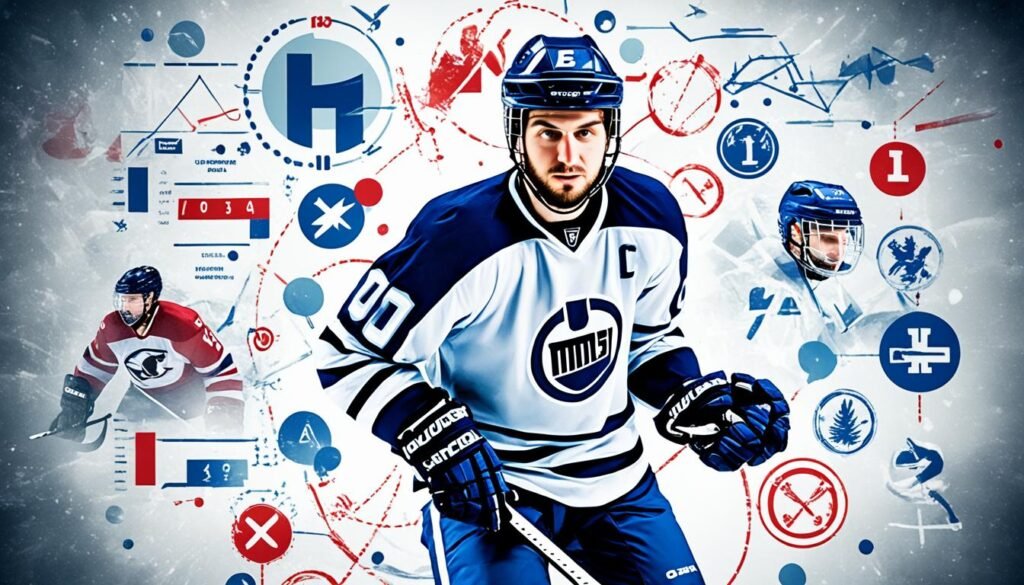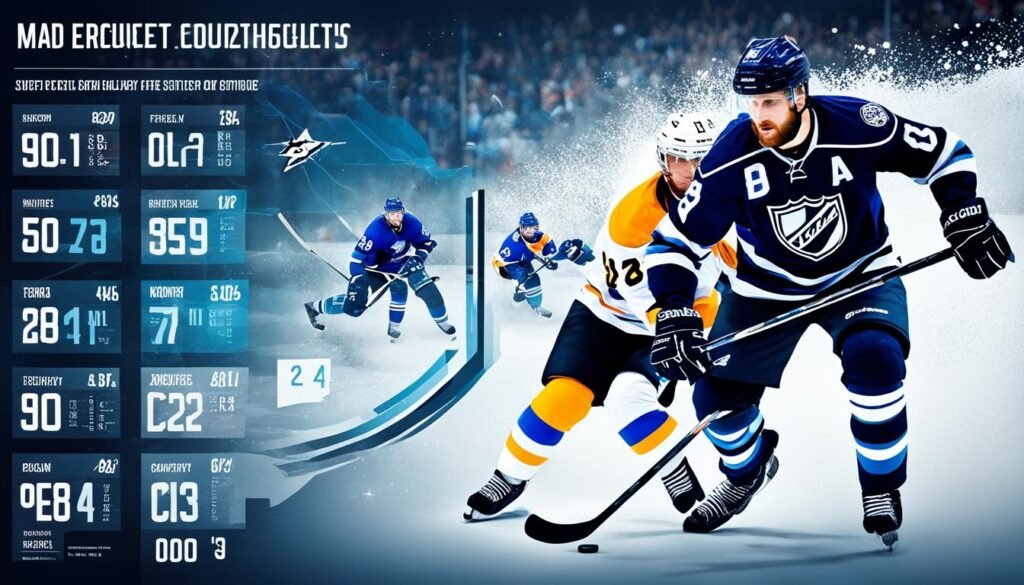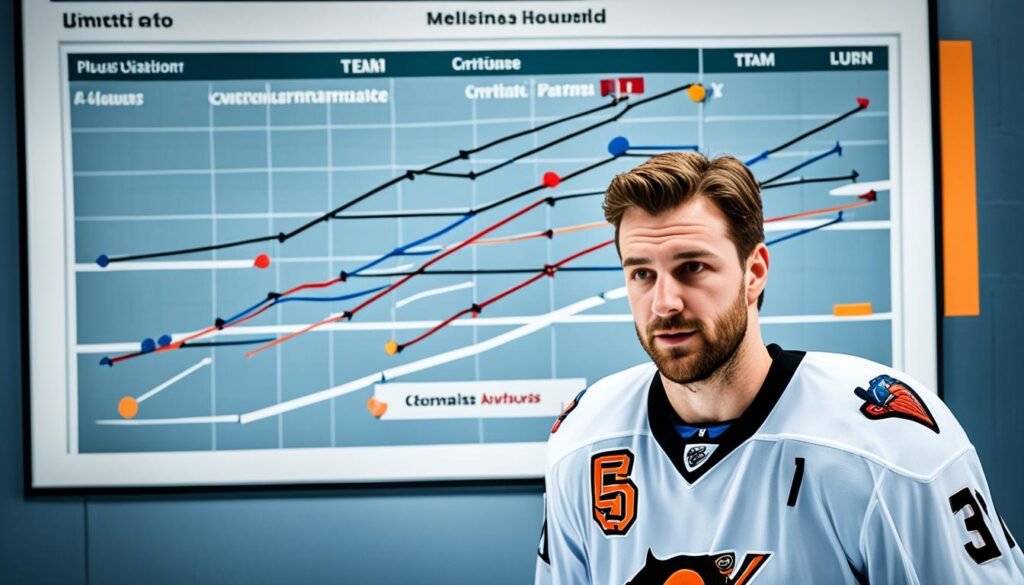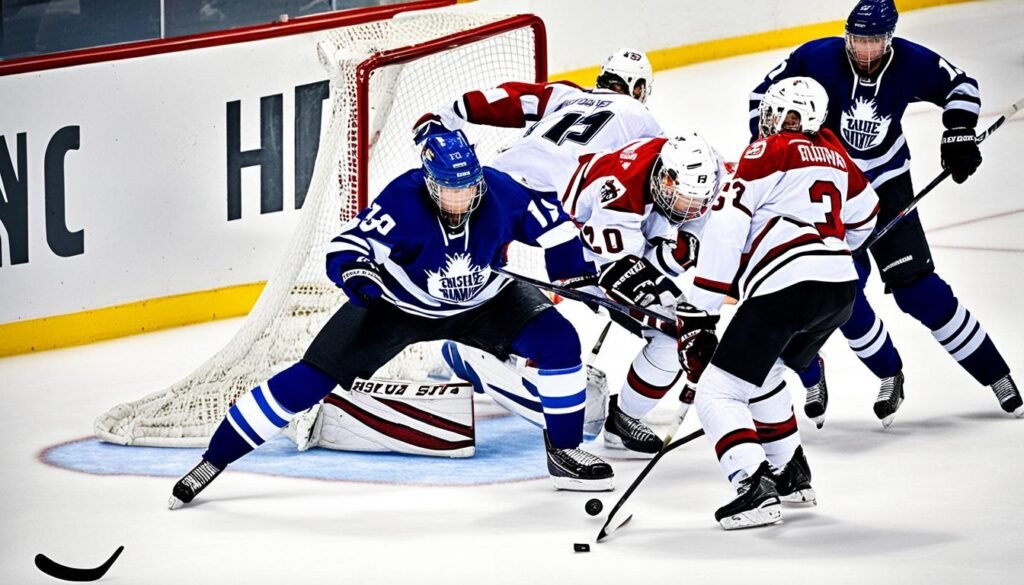Hey there, hockey fans! Today, I want to dive into a fascinating aspect of the game: plus minus hockey. This statistic plays a crucial role in tracking player performance and evaluating their impact on the ice. If you’ve ever wondered how to gauge a player’s effectiveness beyond goals and assists, plus minus hockey holds the key.
So, what exactly is plus minus? Well, it’s a measure that tracks the goal differential when a player is on the ice, taking into account both goals for and against their team. By using this statistic, analysts and team management can gain valuable insights into a player’s contributions to their team’s success.
Throughout this article, we’ll explore the intricacies of plus minus hockey, its calculation, and its significance in evaluating player performance. We’ll also examine the top NHL plus minus leaders and uncover how plus minus fits into the broader realm of advanced hockey analytics. So, join me as we uncover the hidden stories behind the numbers!
Key Takeaways:
- Plus minus hockey is a statistic that tracks the goal differential when a player is on the ice.
- It provides insights into a player’s contributions to their team’s success.
- The calculation involves tallying goals for and against the player’s team.
- Top NHL plus minus leaders demonstrate their impact on team performance.
- Plus minus is just one aspect of advanced hockey analytics.
The Basics of Hockey Statistics and Player Performance Tracking
When it comes to evaluating player performance in hockey, statistics play a crucial role. By analyzing and tracking key metrics, coaches, scouts, and analysts gain valuable insights into a player’s contributions to the game. Hockey statistics, also known as ice hockey metrics, provide a quantitative measure of player performance and help teams make informed decisions.
But what are these statistics, and how are they used to track player performance?
Let’s take a closer look at some of the basic hockey statistics and how they contribute to player evaluation.
One essential hockey statistic is the plus minus rating, which we’ll explore in detail in later sections. Additionally, other important metrics include:
- Goals scored: The number of times a player successfully puts the puck in the opponent’s net.
- Assists: The number of times a player contributes to a goal by assisting a teammate.
- Points: The total sum of goals and assists a player has accumulated.
- Time on Ice (TOI): The amount of playing time a player spends on the ice during a game.
These are just a few examples of the many statistics used to assess player performance. Each metric provides valuable information about a player’s offensive and defensive capabilities, allowing teams to make strategic decisions and adjustments.
Player performance tracking goes beyond basic statistics. Advanced analytics and software help analyze player movement, shooting accuracy, and other performance indicators. These tools provide a comprehensive understanding of a player’s impact on the game and help teams optimize their strategies.
Breaking Down the Plus Minus Rating in Hockey
In this section, I will delve into the specifics of the plus minus hockey statistic. I will explain what the plus minus rating represents, why it is significant in evaluating player performance, and how it is calculated.
What Is the Plus Minus Hockey Statistic?
The plus minus hockey statistic is a measure of a player’s on-ice impact during even-strength situations. It tracks the goal differential when a player is on the ice, with a positive value (+) indicating that the player’s team scored more goals than the opposing team, while a negative value (-) suggests the opposing team scored more goals.
This statistic provides valuable insights into a player’s ability to contribute to their team’s success. A high plus minus rating demonstrates that a player is effective in both offensive and defensive situations, making them a valuable asset on the ice.
Why the Plus Minus Rating Matters
The plus minus rating is an essential component in evaluating player performance and assessing their impact on the game. It goes beyond individual statistics like goals and assists and provides a broader perspective on a player’s overall contribution to their team’s success.
By considering the plus minus rating, coaches, scouts, and analysts can gain a better understanding of a player’s ability to positively influence the outcome of a game. It reflects their ability to make smart decisions, contribute to both scoring and preventing goals, and be a difference-maker on the ice.
How to Calculate Plus Minus in Hockey
The plus minus rating is calculated by subtracting the number of goals scored against a player’s team while they are on the ice from the number of goals scored by their team. The formula is as follows:
Plus Minus Rating = Goals For – Goals Against
For example, if a player’s team scores 10 goals while they are on the ice and the opposing team scores 5 goals, their plus minus rating would be +5.
It’s important to note that this statistic does not account for power play goals or shorthanded goals. It solely reflects a player’s performance during even-strength situations. Additionally, the plus minus rating is cumulative throughout the season, providing a comprehensive measure of a player’s impact over time.
To visualize the calculation of plus minus in hockey, refer to the table below:
| Player | Goals For | Goals Against | Plus Minus Rating |
|---|---|---|---|
| Alex Ovechkin | 25 | 15 | +10 |
| Connor McDavid | 20 | 25 | -5 |
| Patrice Bergeron | 18 | 10 | +8 |


NHL Plus Minus Leaders and Their Impact
In the world of hockey statistics, the plus minus rating stands as a key metric for evaluating a player’s impact on the ice. In this section, we will take a closer look at the top NHL players who have excelled in the plus minus rating and discuss how their performance has impacted their teams.
The plus minus rating measures the difference in goals scored for and against a player’s team while they are on the ice. A positive plus minus rating indicates that the player’s team has outscored the opponents, while a negative rating suggests the opposite. With this in mind, being a plus minus leader is a significant accomplishment, as it demonstrates a player’s ability to contribute to their team’s success.
Let’s take a moment to appreciate some of the NHL’s most impressive plus minus leaders and acknowledge the impact they have had on their respective teams.
To start, we have Connor McDavid, the Edmonton Oilers’ star forward. McDavid has consistently ranked among the league’s top plus minus leaders, showcasing his remarkable ability to contribute both offensively and defensively. His leadership in this statistic has undoubtedly played a crucial role in the Oilers’ success on the ice.
Another remarkable player on the list is Victor Hedman of the Tampa Bay Lightning. As a defenseman, Hedman’s impressive plus minus rating reflects his ability to excel in all areas of the game. His contributions on both ends of the ice have undoubtedly helped propel the Lightning to their championship success.
Furthermore, we cannot overlook the incredible performances by Nathan MacKinnon of the Colorado Avalanche. MacKinnon’s consistent presence among the NHL’s plus minus leaders is a testament to his outstanding skills and overall impact on his team’s success. His ability to make a difference in both offensive and defensive situations is truly remarkable.
These players, among others, serve as shining examples of the impact that a high plus minus rating can have on a team’s overall success. Their ability to contribute on both offense and defense sets them apart and highlights the importance of evaluating players beyond individual statistics.
By analyzing the plus minus rating in combination with other hockey statistics, teams can gain comprehensive insights into the contributions of their players. This holistic view allows for a more accurate assessment of a player’s overall impact on the game.
As the NHL continues to evolve, we can expect the plus minus rating to remain a vital tool in evaluating player performance. Its ability to capture the broader impact a player has on the ice sets the stage for continued success and inspires players to strive for excellence both individually and as part of a team.
Advanced Hockey Analytics: Beyond the Plus Minus Rating
While the plus minus rating is a valuable statistic for evaluating player performance in hockey, advanced hockey analytics provide a deeper understanding of a player’s impact on the game. These analytics go beyond the simplistic plus minus calculation and take into account various advanced metrics and statistics to provide a more comprehensive analysis of player performance.
Advanced hockey analytics utilize a wide range of data, including puck possession, shot metrics, zone entries, and player tracking, among others, to uncover hidden insights and patterns. By analyzing these advanced metrics, analysts and coaches can gain a more detailed understanding of a player’s contributions to the team and their effectiveness in different situations.
One example of advanced hockey analytics is the usage of Corsi and Fenwick metrics. Corsi measures shot attempts (shots on goal, missed shots, and blocked shots) while Fenwick excludes blocked shots. These metrics provide a more accurate representation of a team’s offensive and defensive performance and can help identify players who contribute positively or negatively to shot differentials.


Player tracking data is another valuable resource in advanced hockey analytics. Using technologies such as player tracking systems, analysts can gather detailed information about a player’s movements on the ice, including speed, direction, and distance covered. This data enables the evaluation of a player’s positioning, defensive coverage, and offensive contributions in a more granular manner.
Furthermore, advanced hockey analytics also incorporate statistical models and machine learning algorithms to predict player performance, simulate game scenarios, and optimize team strategies. These models consider various factors such as historical performance, player matchups, and situational context to generate insights that can drive decision-making and player development.
By incorporating advanced hockey analytics into player evaluations and team strategies, hockey organizations can gain a competitive edge in today’s data-driven game. These analytics provide a more nuanced understanding of player performance, allowing teams to make informed decisions on player acquisitions, line combinations, and in-game tactics.
| Advanced Hockey Analytics | Description |
|---|---|
| Corsi | Measures shot attempts (shots on goal, missed shots, and blocked shots) |
| Fenwick | Similar to Corsi, but excludes blocked shots |
| Player Tracking | Utilizes player movement data to analyze positioning and performance |
| Statistical Models | Use historical data and machine learning to predict performance and optimize strategies |
Comparing NHL Plus Minus Stats Across Eras
In the world of hockey, the plus minus statistic has long been used to evaluate player performance on the ice. This metric measures the goal differential while a player is on the ice, providing insights into their impact on the team’s success. But how have plus minus stats evolved over the years? Let’s take a closer look at the historical leaders in plus minus hockey and the evolution of tracking this important rating.
Historical Leaders in Plus Minus Hockey
Over the course of NHL history, there have been several standout players who have consistently excelled in the plus minus rating. These legendary individuals have demonstrated their ability to contribute significantly to their team’s success while on the ice. By analyzing the historical leaders in plus minus hockey, we can gain valuable insights into the skills and strategies that have shaped the game.
The Evolution of Tracking Plus Minus Rating
The process of tracking plus minus stats has undergone notable changes and developments throughout the years. In the early days of hockey, manual record-keeping was employed to track this metric. However, advancements in technology have revolutionized the way the plus minus rating is calculated and analyzed. Today, sophisticated tracking systems and analytics software provide a more accurate and comprehensive view of player performance on the ice.
How the Plus Minus Formula Affects Player Evaluations
In order to accurately evaluate a hockey player’s performance, it is essential to understand how the plus minus formula impacts player evaluations. The plus minus rating is a statistic that measures the difference in goals scored for and against a team while a player is on the ice. This statistic is often used to gauge a player’s overall effectiveness and contribution to their team’s success.


Understanding Plus Minus in Context
While the plus minus rating can provide valuable insights into a player’s defensive abilities, it must be considered in the context of the game and the team’s overall performance. A player with a high plus minus rating may not necessarily be the most skilled or impactful player on the ice. Factors such as the quality of teammates and opponents, ice time, and playing style can all affect a player’s plus minus rating.
Limitations and Critiques of Plus Minus Ratings
Despite its widespread use, the plus minus rating has its limitations and has faced criticism from hockey analysts. Some of the notable critiques include:
- Contextual factors: The plus minus rating does not account for situational factors, such as power play or penalty kill situations, which can heavily influence a player’s plus minus performance.
- Variance in team performance: A player on a highly skilled offensive team may have a high plus minus rating due to their team’s scoring prowess, regardless of their individual contributions.
- Single-season fluctuations: Plus minus ratings can be influenced by random fluctuations and small sample sizes, making it less reliable as a long-term measurement of a player’s performance.
While the plus minus rating can offer valuable insights, it is important to consider these limitations and critiques when evaluating player performance. It should be used in conjunction with other statistics and analysis methods to form a comprehensive understanding of a player’s impact on the game.
Best Hockey Players by Plus Minus
In the world of hockey, the plus minus stat provides valuable insight into a player’s impact on the game. It is a measure of how many goals a player’s team scores versus how many goals they allow when that player is on the ice. A high plus minus rating indicates a player who contributes to their team’s success, while a low rating may suggest areas for improvement.
When evaluating the best hockey players based on their plus minus ratings, several names stand out. Their consistent performance and ability to make a positive impact on the game are commendable. Let’s take a look at some of these outstanding players:
| Player | Team | Plus Minus Rating |
|---|---|---|
| Patrice Bergeron | Boston Bruins | +135 |
| Anze Kopitar | Los Angeles Kings | +123 |
| Ryan O’Reilly | St. Louis Blues | +103 |
| Aleksander Barkov | Florida Panthers | +101 |
| Sean Couturier | Philadelphia Flyers | +95 |
These players have consistently demonstrated their ability to make significant contributions to their teams’ success. Their plus minus ratings serve as a testament to their on-ice performance and the impact they have on the game. It is worth noting that the plus minus rating is just one metric used to evaluate player performance, and there are other factors to consider when assessing a player’s overall contributions.
For fans and analysts alike, studying the performance of the best hockey players by plus minus can provide valuable insights into player impact and the strategies that lead to success. Watching these players in action can inspire and motivate aspiring athletes to improve their own skills and strive for greatness on the ice.
How to Improve Plus Minus in Hockey: Strategies for Players
To improve your plus minus rating in hockey, it’s important to focus on developing specific skills and adopting effective training techniques. By honing these skills and incorporating targeted training into your routine, you can enhance your performance on the ice and contribute more positively to your team’s success.
Skills That Influence the Plus Minus Rating
Several skills can directly impact your plus minus rating in hockey. By mastering these skills, you can increase your effectiveness on both ends of the ice and improve your overall performance.
- Defensive positioning: Maintaining strong defensive positioning is crucial for preventing opponents from scoring. By being in the right place at the right time, you can minimize scoring opportunities and reduce the risk of being on the ice for goals against.
- Stick handling: A strong stick handling ability allows you to maintain possession of the puck and make accurate passes, reducing the likelihood of turnovers that could lead to goals against.
- Reading the play: Developing strong hockey sense and reading the play can help you anticipate the movements of opponents and teammates. This allows you to make intelligent defensive decisions and contribute to offensive opportunities.
- Effective backchecking: Being diligent in your backchecking efforts can help you disrupt opponent’s rushes and prevent scoring chances. By applying pressure in the defensive zone, you reduce the likelihood of goals against.
Training Techniques for a Better Plus Minus Record
Improving your plus minus record requires targeted training that focuses on enhancing specific skills and conditioning. Incorporating these techniques into your training regimen can help you elevate your performance on the ice:
- Defensive drills: Incorporate defensive drills into your training to improve your defensive positioning, backchecking, and overall defensive awareness.
- Puck control exercises: Regularly practice stick handling and puck control exercises to enhance your ability to maintain possession, make accurate passes, and minimize turnovers.
- Film study: Analyze game footage, focusing on your positioning and decision-making in both offensive and defensive situations. This helps identify areas for improvement and fine-tune your overall game.
- Conditioning and endurance training: Develop your physical conditioning and endurance through regular cardio exercises, such as cycling or running. This ensures you can maintain a high level of performance throughout the game.
- On-ice communication: Practice effective communication with your teammates on the ice to enhance your overall team defense and contribute to better defensive awareness.
By incorporating these strategies and techniques into your training and game preparation, you can enhance your skills, improve your plus minus record, and make a more significant impact on the ice. Remember, consistent effort, dedication, and attention to detail are key to improving your performance and contributing to your team’s success.


Analyzing Plus Minus Stats with Hockey Analytics Software
In the world of hockey analytics, the analysis of plus minus statistics plays a crucial role in understanding player performance and team dynamics. By utilizing advanced hockey analytics software, teams and analysts are able to delve deeper into plus minus stats and gain valuable insights that go beyond the surface level.
Hockey analytics software allows for a comprehensive analysis of plus minus statistics by providing tools and features that aid in the interpretation and visualization of the data. This software enables users to analyze plus minus stats in real-time, track player performance over time, and compare different players’ contributions to their teams.
With the help of hockey analytics software, analysts can identify patterns, trends, and correlations within the plus minus statistics. This allows them to evaluate the impact of individual players on team success, identify areas for improvement, and make informed decisions to optimize team strategies.
By utilizing advanced statistical models and algorithms, hockey analytics software can provide in-depth insights into the plus minus statistic, including the influence of various factors such as ice time, line combinations, and game situations. This level of analysis helps teams identify the most effective strategies and tactics to maximize player performance and team success.
In addition to analyzing plus minus stats, hockey analytics software also allows for the integration of other advanced metrics and statistics. This holistic approach provides a comprehensive understanding of player performance and team dynamics, enabling teams to make data-driven decisions and gain a competitive edge.
Overall, the use of hockey analytics software revolutionizes the analysis of plus minus statistics, providing teams and analysts with powerful tools to evaluate player performance and optimize team strategies. By leveraging advanced technologies, teams can unlock hidden insights, enhance player development, and ultimately improve their performance on the ice.
Conclusion
Understanding plus minus hockey statistics is crucial in evaluating a player’s impact on the game. The plus minus rating provides valuable insights into a player’s performance by tracking their individual contribution to goals scored and goals allowed while they are on the ice. By analyzing this statistic, coaches, scouts, and fans can gain a deeper understanding of a player’s effectiveness and overall value to the team.
Throughout this article, we have explored the basics of hockey statistics, delved into the specifics of the plus minus rating, and examined its significance in various contexts. We have also discussed the limitations and critiques of plus minus ratings, as well as the importance of considering context when interpreting this statistic.
To further enhance your knowledge in this area, I encourage you to explore the vast world of hockey statistics. There are numerous advanced metrics and analytics tools available that can provide deeper insights into player performance and team dynamics. By diving into these resources, you can gain a competitive edge in understanding and evaluating the impact of plus minus hockey statistics.
So, whether you are a dedicated hockey fan, a player looking to improve your performance, or someone involved in player evaluation and team management, understanding plus minus statistics is essential. By harnessing the power of this statistic and exploring other hockey analytics, you can gain valuable insights into player impact and contribute to the continued growth and innovation in the sport.

